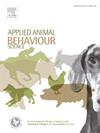Social structure and interactions of laying hens: Limited differences between small and large groups
IF 2
2区 农林科学
Q1 AGRICULTURE, DAIRY & ANIMAL SCIENCE
引用次数: 0
Abstract
As the egg-laying industry transitions from cages to cage-free housing, laying hens are increasingly housed in large groups. Cognitive limitations may impair recognition of conspecifics in such large groups, raising questions on the hens’ ability to form dominance hierarchies as in natural settings. While some studies suggest reduced aggression in larger groups and potential changes in assessment of conspecifics, systematic investigations of social structures and its impact on individuals are lacking. Therefore, we assessed social interactions and structure of 418 White Leghorn hens divided into six pens (three small groups of 20, three large groups of ∼120). From 10–12 and at 24 weeks of age (WoA), we observed social interactions across all hens within a pen and employed Elo ratings, a ranking approach suited for large groups, to assess dominance rank. Furthermore, using 14 focal hens from each group (N = 84), at 16 WoA we tested fear responses (latency to emerge; choice between food and conspecific) and at 26 WoA assessed recognition (choice between flockmate and non-flockmate) and measured body weight and comb size. Contrary to expectations, social structures seemed to be consistent across small and large groups. Within each group, steepness (>0.79) and transitivity (>0.70) were high, indicating hierarchical structures across both group sizes. Top-ranking individuals accounted for over 70 % of interactions in both group sizes and aggression followed a downward heuristic, demonstrating uniform aggression against lower-ranking individuals irrespective of group size. Group size did not significantly affect the number of aggressive interactions per individual or the fear responses. We also found no significant effect of weight or comb size on the rank in either group size. However, in the recognition test, hens from large groups tended to spend more time with the first individual encountered, regardless of flock-origin, whereas hens in small groups preferred the flockmate, suggesting that recognisability only influences social decisions in small groups. Taken together, our findings challenge the current notion of reduced aggression in large groups of chickens and suggest that hierarchical structures exist in large groups. The observed social dynamics may pose challenges for low-ranking hens in large flocks, due to the pecking pressure exerted by increased numbers of higher-ranking hens.
蛋鸡的社会结构和相互作用:小群体和大群体之间的有限差异
随着蛋鸡行业从笼饲养向无笼饲养过渡,蛋鸡越来越多地成群饲养。认知限制可能会削弱在如此大的群体中对同类的识别,从而对母鸡在自然环境中形成统治等级的能力提出质疑。虽然一些研究表明,在较大的群体中,攻击行为会减少,对同种个体的评估可能会发生变化,但缺乏对社会结构及其对个体影响的系统调查。因此,我们评估了418只白来亨鸡的社会互动和结构,这些鸡被分成6个圈(3个20只的小组,3个120只的大组)。从10-12周龄和24周龄(WoA)开始,我们观察了围栏内所有母鸡的社会互动,并采用Elo评级(一种适用于大群体的排名方法)来评估优势等级。此外,每组选取14只局灶母鸡(N = 84),在16 WoA时,我们测试了恐惧反应(出现潜伏期;在26岁时评估识别能力(选择配偶和非配偶),并测量体重和梳子大小。与预期相反,社会结构在大小群体中似乎是一致的。在每个组中,陡峭度(>0.79)和传递性(>0.70)都很高,表明两个组的层次结构都很高。在群体规模和攻击行为中,排名靠前的个体占70%以上 %,遵循向下启发式,无论群体规模大小,对排名靠后的个体都表现出一致的攻击行为。群体规模对个体攻击性互动次数和恐惧反应没有显著影响。我们还发现体重或梳子大小对两组大小的排名没有显著影响。然而,在识别测试中,来自大群体的母鸡倾向于花更多的时间与第一个遇到的个体在一起,而不管来自哪个群体,而小群体的母鸡更喜欢同伴,这表明识别性只影响小群体的社会决策。综上所述,我们的研究结果挑战了目前关于大群体鸡的攻击性降低的观点,并表明大群体中存在等级结构。观察到的社会动态可能对大群中低等级母鸡构成挑战,因为高等级母鸡数量的增加施加了啄食压力。
本文章由计算机程序翻译,如有差异,请以英文原文为准。
求助全文
约1分钟内获得全文
求助全文
来源期刊

Applied Animal Behaviour Science
农林科学-行为科学
CiteScore
4.40
自引率
21.70%
发文量
191
审稿时长
18.1 weeks
期刊介绍:
This journal publishes relevant information on the behaviour of domesticated and utilized animals.
Topics covered include:
-Behaviour of farm, zoo and laboratory animals in relation to animal management and welfare
-Behaviour of companion animals in relation to behavioural problems, for example, in relation to the training of dogs for different purposes, in relation to behavioural problems
-Studies of the behaviour of wild animals when these studies are relevant from an applied perspective, for example in relation to wildlife management, pest management or nature conservation
-Methodological studies within relevant fields
The principal subjects are farm, companion and laboratory animals, including, of course, poultry. The journal also deals with the following animal subjects:
-Those involved in any farming system, e.g. deer, rabbits and fur-bearing animals
-Those in ANY form of confinement, e.g. zoos, safari parks and other forms of display
-Feral animals, and any animal species which impinge on farming operations, e.g. as causes of loss or damage
-Species used for hunting, recreation etc. may also be considered as acceptable subjects in some instances
-Laboratory animals, if the material relates to their behavioural requirements
 求助内容:
求助内容: 应助结果提醒方式:
应助结果提醒方式:


